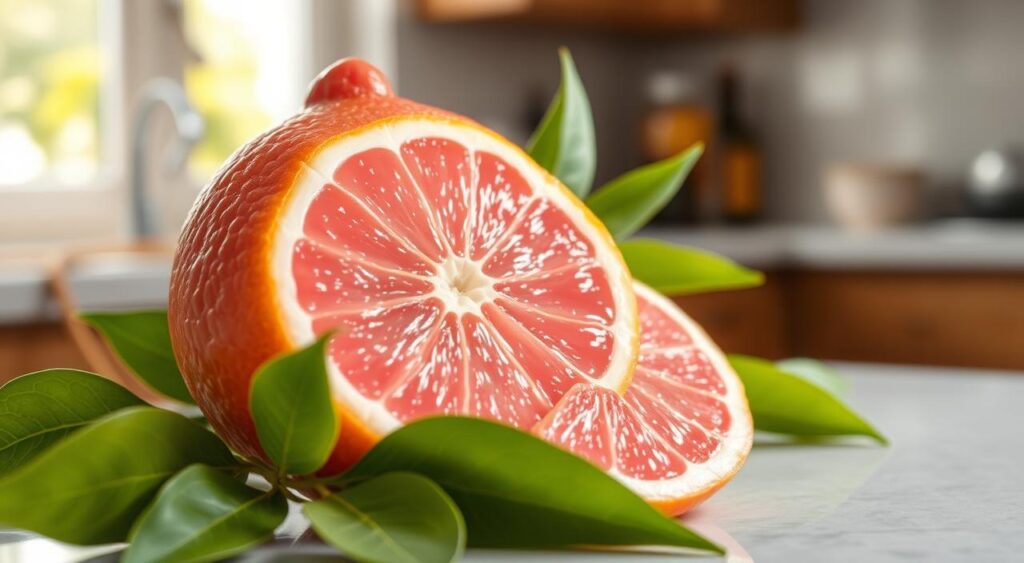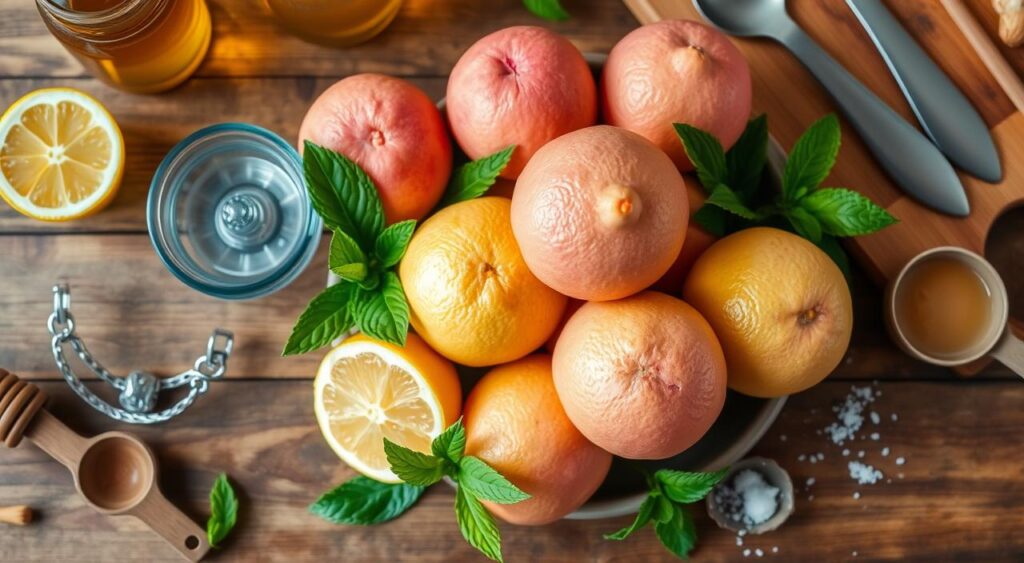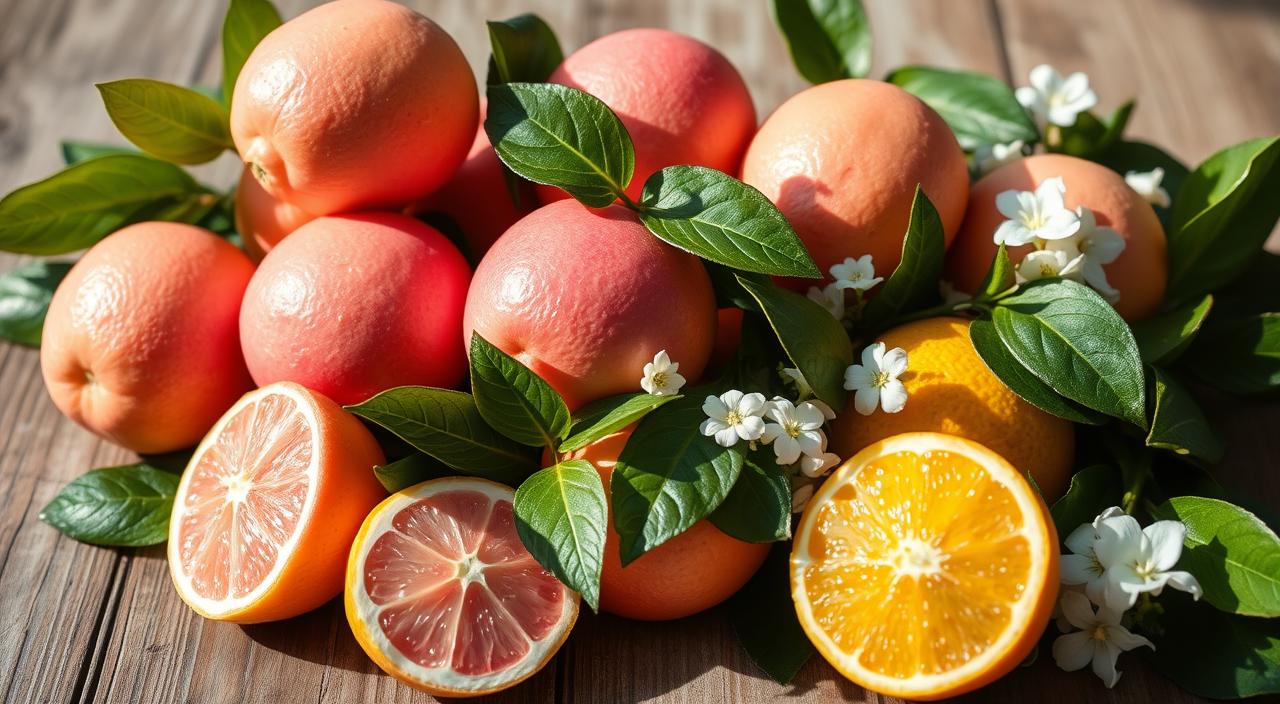As the sun warms the air and days get longer, we all crave something refreshing. pink lemon is the perfect answer. Its bright color and perfect mix of sweet and sour make it a favorite. But where did this citrus wonder come from?
Let’s dive into the world of pink lemons. We’ll find out how to make the best pink lemonade. Your taste buds will thank you.
Understanding the Magic of Pink Lemons

Get ready to be amazed by pink lemons – a rare and unusual flavor that makes classic citrus recipes even better. These colorful fruits are more than just a tropical delicacy. They show the incredible variety of nature.
Natural vs. Artificial Pink Citrus
It’s key to know the difference between real pink lemons and fake ones. Pink lemonade, often made with grape or cranberry juice, is not the same. True pink lemons get their color from a natural genetic change. This rare variety of citrus has pinkish-red flesh and juice.
History and Origins of Pink Varieties
The story of pink lemons starts with a chance mutation in lemon trees. A natural genetic change led to these unique fruits. Now, pink lemon fans can enjoy their refreshing taste and tropical delicacy.
Nutritional Benefits and Properties
Pink lemons are as nutritious as regular lemons. They’re full of vitamin C, antioxidants, and other important nutrients. The pink color comes from lycopene, the same antioxidant found in tomatoes. So, eating or drinking things with pink lemon not only tastes great but also boosts your health.
Essential Tools and Ingredients for Pink Lemon Recipes

Making pink lemon recipes is fun with the right tools and ingredients. First, you need a juicer to get the zesty tang from pink lemons. A good zester adds a citrus touch to your dishes. And, a pitcher with a pour spout is perfect for mixing up summertime treats.
You’ll also need fresh pink lemons, filtered water, and a sweetener like raw honey or organic cane sugar. For a natural pink color, add watermelon or beet juice. Using fresh ingredients is key for the best flavor in your homemade lemonade.
“The secret to the perfect pink lemonade lies in the balance of tart and sweet, with a vibrant color that captures the essence of summer.”
With the right tools and ingredients, you’re ready to make zesty and delightful pink lemon recipes. They’ll make your taste buds happy all season long.
Classic Pink Lemonade: A Vibrant Twist on Tradition
Imagine a drink that grabs your attention with its vibrant hues and exciting tastes. Welcome to classic pink lemonade, a fun twist on a summer favorite. It’s a refreshing drink that’s perfect for cooling down and adding a bit of exotic produce to your day.
Selecting the Perfect Sweetener
Finding the right sweetener is key to great pink lemonade. While sugar is common, try honey or agave nectar for more flavor. Find the perfect mix of sweet and tart by adjusting the sweetener and lemon juice.
Natural Coloring Techniques
For a true pink lemonade, skip artificial colors. Use beet, watermelon, or cranberry juice for a natural vibrant pink. This makes your lemonade not only tasty but also beautiful.
Serving and Presentation Tips
Make your pink lemonade stand out with great presentation. Serve it in tall glasses with ice, mint, and lemon. This mix of taste and look will make your guests feel like they’re in a world of exotic produce and summer fun.
“The perfect pink lemonade is a symphony of flavors, where tartness and sweetness dance in perfect harmony, creating a refreshing elixir that quenches the thirst and delights the senses.”
Creative Cocktails and Mocktails with Pink Lemon
Summertime is the perfect time for refreshing drinks. Pink lemons add a unique twist to both cocktails and mocktails. They bring a vibrant flavor to any drink.
Infuse your favorite cocktail with pink lemon juice for a tart touch. The Pink Lemonade Cocktail mixes vodka, Malibu, cranberry juice, lime, and sprite. It’s served over edible flower ice cubes for a beautiful look. You can adjust the cranberry juice to change the color from soft pink to bold fuchsia.
“Elevate your summer sipping with these creative pink lemon cocktails and mocktails!”
For a drink without alcohol, try the Tropical Pink Mocktail. It’s a mix of grenadine syrup, pina colada mix, and lemon-lime soda. Top it with fresh fruit slices for a summer vibe.
Want to impress at an event? Make the Pink Drink (Baby Shower Punch). It’s a simple mix of pink lemonade mix, pineapple juice, and Sprite. This punch is a hit at any summer gathering.
Culinary Applications Beyond Beverages
Pink lemons are not just for drinks. They add a zesty tang to many dishes, from sweet treats to savory meals. Try them in desserts, main courses, and even preserves.
Dessert Recipes and Pastries
Use pink lemons in cakes, tarts, and sorbets. Their bright color and tangy taste mix well with creamy and flaky textures. Try making pink lemon curd, meringues, or sorbet for a fun twist on desserts.
Savory Dishes and Marinades
Pink lemons can also spice up savory dishes. Use their juice and zest in marinades for fish or poultry. Add pink lemon slices or wedges to grilled meats or roasted veggies for a burst of flavor and color.
Preserves and Condiments
Make homemade preserves like tangy curd or vibrant marmalade with pink lemons. These condiments are great on toast, scones, or as a glaze for baked goods. Pink lemon juice also adds a zesty touch to salad dressings and sauces.
“The possibilities with pink lemons are endless. Their vibrant hue and tropical delicacy can elevate any dish, from sweet to savory.”
Tips for Growing Your Own Pink Lemons
Introducing the rare and exotic pink lemon – a unique citrus variety that adds a vibrant twist to your culinary creations. Growing your own pink lemons is rewarding. The process is similar to growing regular lemon trees.
Pink lemon trees love warm climates and lots of sunshine. They need at least 6-8 hours of direct sunlight daily. These trees are hardy in USDA zones 9-10, fitting many regions. Make sure the soil drains well and has a pH between 6.0 and 8.0 for the best results.
Newly planted pink lemon trees need lots of water in their first year to grow strong roots. After that, they can handle some drought. But, they still need regular watering, especially in the summer. For plants in containers, water them 1-3 times a week, adjusting as needed.
“Pink lemons are known for their resiliency, being drought-resistant and pest-resistant.”
Regular pruning helps your pink lemon tree stay healthy and produce more fruit. Prune in the spring and summer. Remove any suckers or branches that are too long to let the tree grow well.
With the right care, your pink lemon tree will give you lots of these rare variety and exotic produce. Enjoy their vibrant colors and unique flavors in your cooking!
Seasonal Availability and Storage Guidelines
Pink lemons are a tropical treat with a short peak season, from late winter to spring. When picking, choose fruits that are firm and heavy. This means they’re fresh and juicy. Store them at room temperature for up to a week or in the fridge for a month.
Peak Season Selection
The peak season for pink lemons is late winter to spring. This is when they’re at their best, with a sweet and tangy taste. Look for lemons that are heavy and have smooth skin when you’re picking.
Proper Storage Methods
Proper storage keeps pink lemons fresh longer. Store them at room temperature for up to a week. For longer storage, refrigerate them for up to a month. You can also freeze the juice in ice cube trays for later use.
“The vibrant hue and unique flavor of pink lemons make them a true treasure in the citrus world.”
Health Benefits and Wellness Applications
Pink lemons are not just pretty; they’re packed with health benefits. They have almost 60% of the daily vitamin C you need in just one fruit. This vitamin is a strong antioxidant that boosts your immune system and helps your body absorb iron better.
The citric acid in pink lemons can also help prevent kidney stones. Drinking half a cup of lemon juice a day can give you enough citric acid to fight off these stones. Plus, pink lemons have soluble fiber and complex carbs that are good for your gut and can help control blood sugar.
“Lemons contain roughly 17 calories per fruit and are free of saturated fats, trans fats, and cholesterol, making them a nutritious and low-calorie addition to your diet.”
The pink color of these fruits is a sign of their high lycopene content. Lycopene is a strong antioxidant that may lower the risk of some cancers. So, pink lemons are great for boosting your immune system, improving digestion, or just enjoying a tasty citrus treat.
Conclusion
Pink lemons stand out in the kitchen world. They have a bright color and a refreshing, sweet taste. They add a fun twist to lemon recipes.
You can make pink lemonade, vibrant desserts, or add them to savory dishes. The options are endless.
Use pink lemons in your cooking to find the perfect mix of sweet and tart. Let your creativity flow as you try new recipes. Their color and taste will make your dishes stand out.
Exploring pink lemons is a fun journey. Enjoy their refreshing and healthy qualities. They inspire you to make dishes that wow your loved ones.
Make pink lemons a key part of your cooking. It will add a special touch to your meals. Enjoy the journey of discovering new recipes with pink lemons.
FAQ
What is the history behind pink lemonade?
Pink lemonade started in American circuses. It was made by adding cinnamon candies or red tights dye to lemonade. Now, beet juice is used to make it pink without changing the taste.
How are pink lemons different from artificially colored pink lemonade?
Pink lemons naturally have pink juice, unlike colored lemonade. This juice comes from a special lemon tree mutation. Artificial lemonade uses dye or juice for color.
What are the essential tools and ingredients for making pink lemonade?
You’ll need a juicer, zester, and pitcher for pink lemonade. Use fresh pink lemons, water, and honey or sugar for sweetness. Beet or watermelon juice can color it naturally.
How do you make the best pink lemonade?
The best recipe uses simple syrup for sweetness. Beet, watermelon, or cranberry juice can color it. Serve in tall glasses with ice, mint, and lemon slices. The mix includes 2 cups lemon juice, 8-10 cups water, and 2 cups sugar, with color added to taste.
How can pink lemons be used in cocktails and mocktails?
Pink lemons add color to cocktails and mocktails. Mix it with classic drinks for a twist, or make mocktails with sparkling water and herbs. Try adding watermelon, strawberry, or basil for extra flavor.
What are some culinary applications for pink lemons beyond beverages?
Pink lemons are great in desserts like cakes and tarts. Use them in savory dishes for fish or poultry marinades. Make curd, marmalade, or salad dressings for a unique taste and color.
How can you grow your own pink lemon trees?
Pink lemons need warm weather and full sun like regular lemons. Plant in good soil and water often. Grow them in pots to move them in cold weather. Prune to keep shape and encourage fruit.
When are pink lemons available, and how should they be stored?
Pink lemons are in season from late winter to spring. Pick firm, heavy fruits. Store at room temperature for a week or in the fridge for a month. Freeze juice in ice cubes for later.
What are the health benefits of pink lemons?
Pink lemons have lots of vitamin C, antioxidants, and may aid digestion. Use them in detox water or herbal teas. The pink color comes from lycopene, which might have extra health perks.
